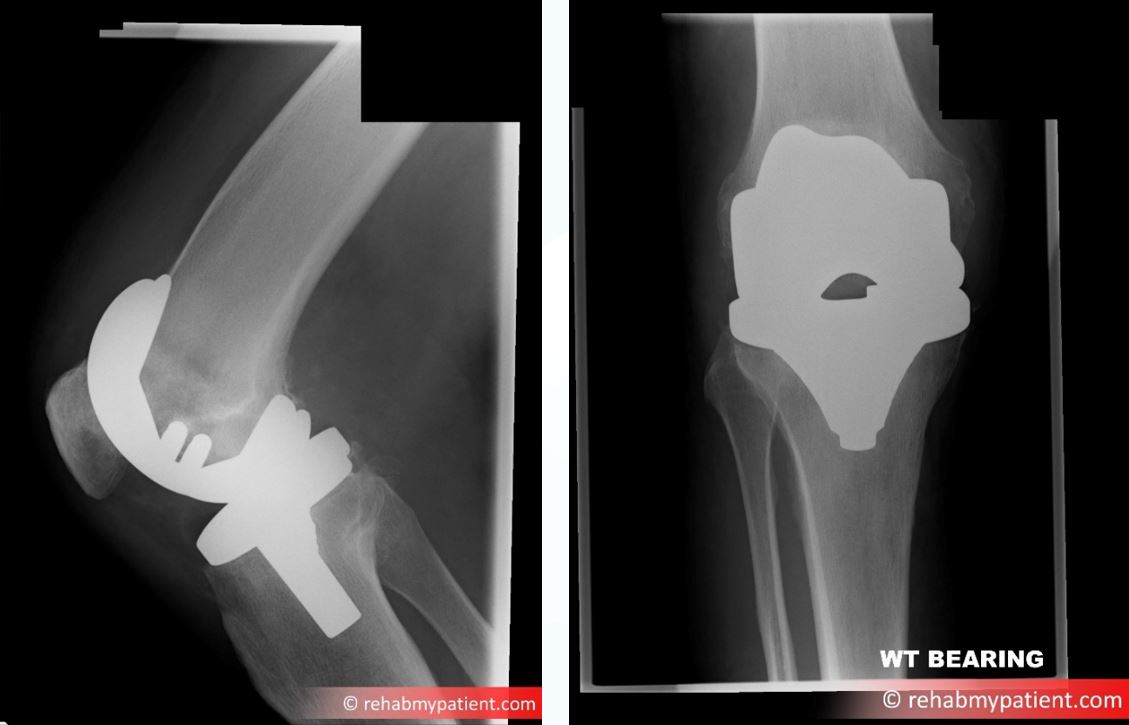
Next steps:
Feel free to read the advice sheet below! To get the full benefit click on 'Start treatment'. By starting the treatment you will get access to weekly rehab programmes online for FREE. You will be able to track your progress, pain levels and we will remind you to do your exercises every day!
If your knee is significantly damaged from injury or arthritis, it might be difficult for you to perform some of the simplest activities, such as climbing stairs or walking. You might begin feeling pain when lying down or sitting. If non-surgical treatments aren’t helpful, you might have no other option than undergoing knee replacement surgery. This is a safe and effective procedure to help in correcting leg deformity, relieving pain and helping you get back to normal activities.
The procedure was first performed in 1968, but since that time, new techniques and materials have significantly increased the effectiveness of the procedure. Total replacements tend to be one of the most successful of all procedures in the medical field. More than 600,000 knee replacements are performed annually in the US.
But How Do You Know If You Need a Knee Replacement?
· First of all, you may have sustained a previous knee injury such as a trauma to the knee or twisting sports injury.
· Or you may have a family history of arthritis.
· You likely have swelling and gross stiffness in the knee.
· You get pain that wakes you most mornings and doesn’t relieve much during the day.
Before you undergo a knee replacement, you should have tried a course of therapy such as physiotherapy, osteopathy, chiropractic or sports rehabilitation. Often therapy is enough to relieve symptoms and exercises can help to mobilise the stiff joint. You may have also tried acupuncture which has been proved to be successful in reducing pain in people of knee arthritis. You might have also used pain relievers or anti-inflammatories. You may have also had a steroid injection. If these measures are unsuccessful, then you are a good candidate for a knee replacement.
Knee Replacement Anatomy
The knee is one of the biggest and most complex of all joints found in the body. It joins the shin bone and the thigh bone together. The smaller bone running alongside of the tibia and the kneecap are the two other bones that complete the knee joint. Tendons keep the leg muscles and knee bones connected to enable the knee joint to move. Ligaments join all of the knee bones and deliver stability to the knee.
The anterior cruciate ligament is the one that prevents the femur from sliding backward along the tibia. The medial and lateral collateral ligaments make sure the femur doesn’t slide from one side to the other. It is the posterior cruciate ligament that prevents the femur from sliding forward along the tibia.
Knee replacement is usually required when the cartilage is worn, and the meniscus is degenerate. The meniscus is the cushion that sits on top of the cartilage as a cushion or shock absorber. It’s prone to degeneration and tearing.

X-ray showing total knee replacement surgery
Undergoing a Knee Replacement:
A knee replacement is commonly termed resurfacing because only the surface of the bones are replaced. Four basic steps are involved in the replacement procedure.
1. Preparing the Bone
The damaged cartilage surfaces located at the ends of the tibia and the femur are removed with a small portion of the bone underneath.
2. Positioning the Metal Implants
The bone and cartilage that is removed is replaced using metal components recreating the joint surface. The metal parts might be cemented or press-fit into the bone of the knee.
3. Resurfacing of the Patella
The underneath surface of the kneecap is cut and resurfaced using a plastic button. Some of the surgeons don’t resurface the kneecap, but it all depends on your individual case.
4. Inserting a Spacer
A medical-grade plastic spacer is inserted between all of the medical components to create a smooth gliding surface.
Knee replacements can be painful, and following the surgery there will be gross levels of inflammation (swelling) and pain. You will notice the knee is unable to bend fully. It will be extremely important to work with a therapist to rehabilitate following surgery. One of the big risks following surgery is ending up with a very stiff knee due to soft-tissue contractions and scar tissue. Therapy will help prevent this in many cases. It can take up to 18 months for full recovery, but this long is unusual and in many cases knee recovery takes about 6 months. The knee is usually able to fully bend between 6 and 12 weeks.
Tips:
· More than 90 percent of those individuals who have knee replacement surgery will experience a significant reduction in knee pain and their abilities to perform the normal activities of everyday life.
· Total knee replacement isn’t going to allow you to do more than what you were able to do before the arthritis set in.
· Excessive weight or activity can speed the normal wear and tear of the space, which can cause it to loosen and become painful.
· Be careful with jogging, jumping, running or other high-impact sports after your surgery and should only be done under the authorization of your surgeon, if at all.
· Realistic activities you can participate in are swimming, driving, golf, walking, ballroom dancing, biking and other low-impact sports.

